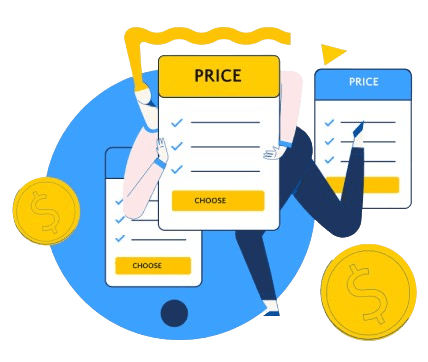
Automate your pricing strategy, react to market changes in real time, and maximize profitability with AI-powered insights.
View PricingPricing was, is, and will always be the crucial part of a business. Prices have never been static. Back then, prices were adjusted occasionally depending on a very few factors. But today, the way prices are set has changed dramatically.
Price adjustment is a continuous process now (won’t be wrong even if we say it as a daily task), either based on demand, timing, customer behavior, competitor moves, or a mix of all. And keeping track of all these manually? Could be a nightmare.
Yes, that’s exactly where Dynamic pricing software comes in.
→ How much does a Dynamic Pricing Software cost?And no, it’s not just used by airlines or hotels today; it has become an essential part of eCommerce. The market moves too fast. Consumer preference can change overnight. One viral video can suddenly spike the demand. Competitors can steal your customers with a flash sale in minutes. All these could happen before you even realize it!
Sticking to fixed prices or updating them manually is lot more risky than you think. If you can’t adapt to the market changes quickly, you might lose both customers and the revenue. That’s why dynamic pricing software is no more a “nice to have”, it’s essential for survival.
Great move that you’ve started your research on Dynamic pricing software. Many tools offer a free trial, giving you a chance to explore before committing.
But what exactly does this software do? How does it work? And how do you know if it’s a right fit for your business?
This guide takes you through everything you need to know. Let’s begin with the basics.

Automate your pricing strategy, react to market changes in real time, and maximize profitability with AI-powered insights.
What Is Dynamic Pricing Software?
Dynamic pricing software is a tool that can be used by online retailers to automatically adjust the prices of their products in real-time. It could be based on time, market demand, inventory levels, customer behavior, competitor moves, or any preset rules.
With this, you can instantly react to the market changes, improve profitability, and make sure you’re always ahead of the competition. No more guesswork or relying on manual updates.
In short, it ensures you’re always offering the right price, both for the market and your margins.
How does it work?
Here’s a simple breakdown of how a Dynamic Pricing Software works:
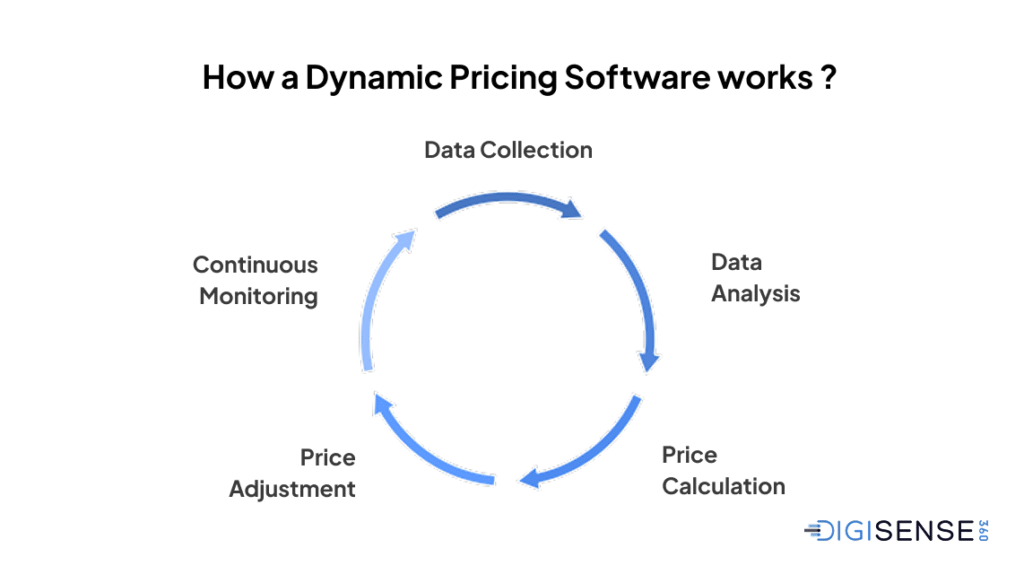
Data Collection
The Dynamic pricing software aggregates a wide range of data from both internal and external sources. Internal data includes information on inventory level, sales history, customer demographics, and production costs. External data includes competitor prices, customer behaviour, market conditions, past trends, and more; which are usually gathered through web scraping.
Data Analysis
By leveraging AI and Machine Learning Algorithms, the collected data is processed to identify patterns and trends. It also forecasts the future demand, price elasticity, and opportunities for optimization, which is crucial for making pricing decisions.
Price Calculation
After applying dynamic pricing algorithm, the system determines the ideal pricing for each product. This involves various pricing models and techniques that evaluates multiple variables to find the price. It also considers the rules and objectives set by the user that trigger pricing changes on predefined conditions. The goal is finding the highest price point optimal at the moment.
Price Adjustment
Then the calculated price is automatically adjusted in real-time across all the platforms without the need for manual intervention. It could also happen multiple times a day; the frequency depends on the set rules and market conditions.
Continuous Monitoring
This cycle repeats, as dynamic pricing is an ongoing process of learning and adaptation. The software consistently monitors your performance and ensures your prices stay competitive and aligned with the market.
Key Features of Dynamic Pricing Software
While Dynamic pricing software comes with a range of features, here are the major ones that move the needle.
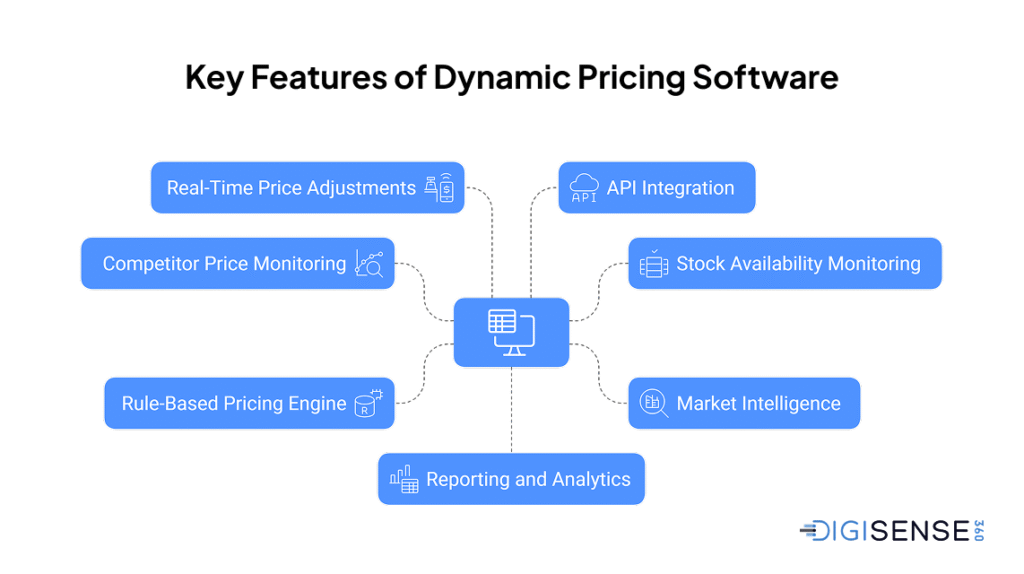
Competitor Price Monitoring
Continuously tracks your competitors, which includes their pricing, promotions, and discounts, helping you understand their strategies more better. The moment they increase or decrease their price, you get instant alerts. Always stay a step ahead.
Stock Availability Monitoring
Keeps track of your inventory level. Either the product is running low or overstocked, the system automatically adjusts the prices accordingly to maximize sales.
Market Intelligence
Closely monitors the market conditions, such as demand patterns, seasonality, customer buying behavior, and more. It helps create a smarter pricing approach based on what’s happening right now in the market.
Rule-Based Pricing Engine
Want to lower your prices when sales dip? Or jump up during peak hours? You can set custom pricing rules as per your need, with the simple “If-Then” rules and formulae. Whether it’s for specific product categories, time based offers, or competitor-triggered actions.
Real-Time Price Adjustments
Automatically adjust the prices of products across all the platforms based on the market conditions and preset rules. And, that too in real-time. No manual effort needed.
API Integration
Integrates with your existing tech stack, let it be ERP, CRM, or any eCommerce platform. The API integration enables a smooth data flow across the systems, avoiding confusions.
Reporting and Analytics
Provides intuitive dashboards that show you what’s really happening. It helps you understand the impact of your pricing decisions (what’s working and what’s not), enabling better decision making.

Automate your pricing strategy, react to market changes in real time, and maximize profitability with AI-powered insights.
Benefits of Dynamic Pricing Software
Whether you are selling a handful of products or thousands, Dynamic pricing software brings in countless benefits. Here are some of the key benefits you get:
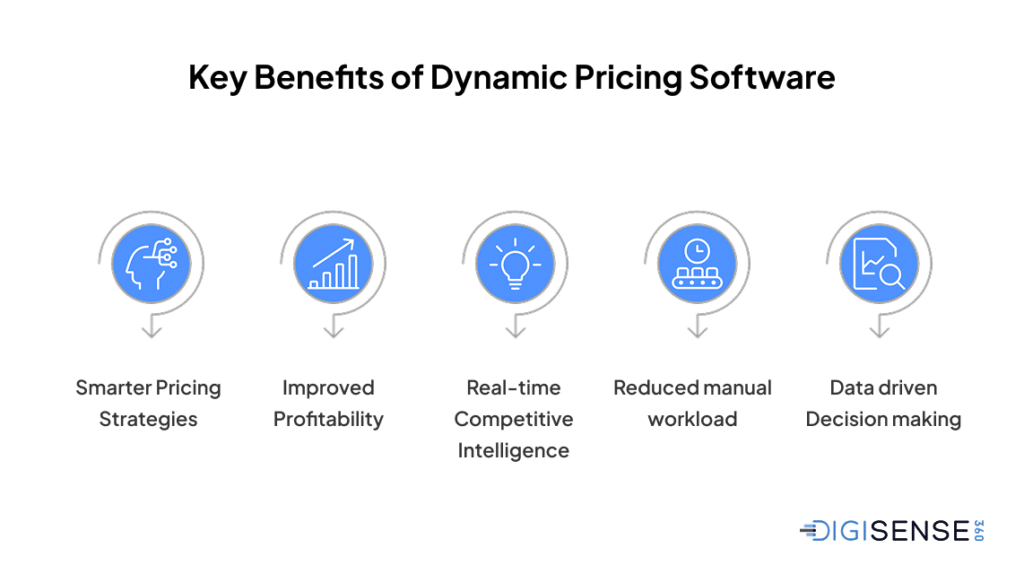
Smarter Pricing Strategies
You get smarter, data-backed pricing by considering a number of variables like demand, competition, seasonality, events, holidays, buyer behavior, stock status, and more. No more hunches!
Improved Profitability
You don’t have to sacrifice margins to keep up with competitors. By aligning prices with the market, you can increase sales, reduce costs, improve your margin, and eliminate the need for unnecessary discounts. Healthier margins and more revenue!
Real-time Competitive Intelligence
By tracking competitor prices and analyzing their strategies in real-time, you get a detailed picture of what’s happening in the market (and where you stand). You don’t just react anymore, you get to anticipate the next move. This ensures you always stay one step ahead of the competition.
Reduced manual workload
Forget spending hours adjusting prices one by one. Automated pricing adjustments eliminate the need for constant monitoring and manual updates, saving a lot of time and effort. As it takes the monotonous work off your table, you can now focus on higher level strategies.
Data driven Decision making
You don’t have to guess if your pricing strategy is working or not. With access to real-time data and performance analytics, you get a deeper understanding of what’s really driving results. So, you can make fast and confident decisions based on facts, and not assumptions.
Do You Need Dynamic Pricing Software?
Confused about whether dynamic pricing software is right for your business? Let’s clear that up.
Ask yourself:
- Are your pricing decisions often based on gut feeling rather than data?
- Do you spend a lot of time manually updating prices across platforms?
- Are your competitors frequently changing prices, and you struggle to keep up?
- Are your profit margins inconsistent or unclear without a clear reason?
- Have you ever missed sales because your prices were too high compared to others?
If your answer is “yes” to most of the questions, dynamic pricing software could be exactly what you need.
Top 5 Dynamic Pricing Tools
DigiSense360
DigiSense360 is a digital shelf analytics platform that provides real-time insights on product listings across marketplaces. It helps to track product rankings, MAP violations, customer reviews, content compliance, competitor prices, and adjust product prices dynamically.
It’s perfect for eCommerce sellers who want complete control over their digital shelf.
Prisync
Prisync is a price tracking software, which helps online sellers monitor competitor prices, stock levels, and apply rule based pricing across the sales channels.
It’s suitable for small to mid-sized businesses that need easy-to-use pricing software.
Vendavo
Vendavo is a price optimization platform that provides pricing analytics, dynamic pricing, rebate & channel management, CPQ, incentive, Ship and debit management.
It’s optimal for enterprise level companies looking for a complete pricing solution.
Pricefx
Pricefx is a price optimization & management software that helps with price setting, dynamic pricing, rebates, channel management, CPQ, agreements, and promotions.
It’s suitable for large businesses wanting an end-to-end pricing suite.
Competera
Competera is an AI-powered pricing optimization platform that provides insights on competitors, customer behavior, various pricing models, and rule‑based repricing.
It’s perfect for enterprise retailers looking to automate their pricing process.
How to Choose the Right Tool
While there are numerous tools available in the market, it is easy to get overwhelmed. Here the the key steps you need to follow to choose the right solution:
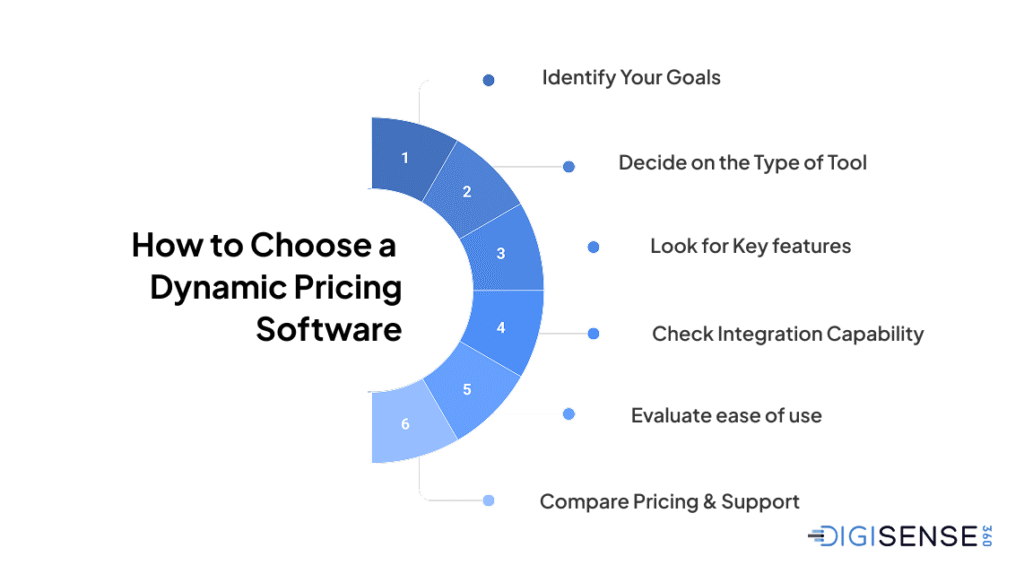
Identify Your Goals
Start by clearly defining what you expect from dynamic pricing software. Are you aiming to improve profit margins, reduce manual work, or react faster to market changes? This forms the foundation for choosing the tool.
Decide on the Type of Tool
Not all pricing tools are built the same. Decide whether you need a Price tracking tool, Repricing tool, Digital Shelf Analytics tool, Revenue Management System, or a Comprehensive Pricing Suite. Which one serves your needs better?
Look for Key features
Don’t get fascinated by the fancy features available (which you don’t even use). Just focus on those key features which you truly need, such as competitor price monitoring, inventory tracking, rule based pricing, or AI-based optimization.
Check Integration Capability
The tool should integrate seamlessly with your existing tech stack. Whether it is ERP, CRM, ecommerce platforms (like Shopify or Magento), or marketplaces (like Amazon or Walmart). Smooth integration is crucial to ease your workflow and improve operational speed.
Evaluate ease of use
Is it easy to use? Can your team adapt to and use it efficiently? Consider the User Interface, onboarding process, and learning resources available. The software should enhance your workflow, not complicate it.
Compare Pricing & Support
Evaluate the pricing model, is it usage-based, fixed, or tiered? Make sure it aligns with your budget and scaling plans. Also, assess the quality of customer support, response time, training availability, etc. Reliable support is crucial.

Automate your pricing strategy, react to market changes in real time, and maximize profitability with AI-powered insights.
Final Thoughts
Pricing shouldn’t feel like a guessing game. If it does, may be it’s time to level up. The market is moving so fast that what worked yesterday might fail today. Trying to keep up with the constantly changing prices manually isn’t just exhausting, but risky.
Hence, dynamic pricing software is no longer a nice-to-have. Whether you’re handling thousands of SKUs or just a few products, it’s necessary to ensure your prices are always aligned with the market.
But remember, there isn’t a one size fits all solution. The key is choosing the right tool, the one that aligns with your business goals. Don’t rush the process. And, don’t run behind every fancy feature that you’ll never use. Take time to understand your needs and evaluate the tools carefully. Pick the one that suits you the best.
Done right, dynamic pricing software doesn’t just automate your price adjustments; it takes your business to the next level. It helps you strengthen your pricing strategy, improve margins, react to market changes faster, reduce manual effort, and back every pricing decision with real-time data. Always stay ahead!
If you want to explore, DigiSense360 has a free trial you can try out without any commitments.
FAQs
Dynamic pricing software is a tool that automatically adjusts product prices in real-time based on factors like competitor prices, inventory levels, and customer behavior, helping businesses stay competitive and maximize profits.
While there isn’t a single dynamic pricing software called universally the best, it depends on your specific needs, business size, goals, and sales channels.
An example of dynamic pricing is airline ticket pricing, where prices fluctuate based on demand, booking time, and remaining seats.
Disadvantages of dynamic pricing include potential customer dissatisfaction due to price fluctuations, complexity in managing pricing rules, and risk of price wars with competitors.

Automate your pricing strategy, react to market changes in real time, and maximize profitability with AI-powered insights.



